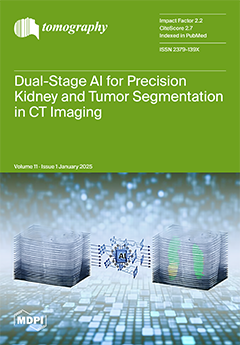Background: Anesthesia can significantly impact positron emission tomography (PET) neuroimaging in preclinical studies. Therefore, understanding these effects is crucial for accurate interpretation of the results. In this experiment, we investigate the effect of [
18F]-labeled glucose analog fluorodeoxyglucose ([
18F]FDG) uptake
[...] Read more.
Background: Anesthesia can significantly impact positron emission tomography (PET) neuroimaging in preclinical studies. Therefore, understanding these effects is crucial for accurate interpretation of the results. In this experiment, we investigate the effect of [
18F]-labeled glucose analog fluorodeoxyglucose ([
18F]FDG) uptake in the brains of rats anesthetized with two commonly used anesthetics for rodents: isoflurane, an inhalation anesthetic, and Hypnorm–Dormicum, a combination injection anesthetic. Materials and Methods: Female adult Sprague Dawley rats were randomly assigned to one of two anesthesia groups: isoflurane or Hypnorm–Dormicum. The rats were submitted to dynamic [
18F]FDG PET scan. The whole brain [
18F]FDG standard uptake value (SUV) and the brain voxel-based analysis were performed. Results: The dynamic [
18F]FDG data revealed that the brain SUV was 38% lower in the isoflurane group after 40 min of image (2.085 ± 0.3563 vs. 3.369 ± 0.5577,
p = 0.0008). In voxel-based analysis between groups, the maps collaborate with SUV data, revealing a reduction in [
18F]FDG uptake in the isoflurane group, primarily in the cortical regions, with additional small increases observed in the midbrain and cerebellum. Discussion and Conclusions: The observed differences in [
18F]FDG uptake in the brain may be attributed to variations in metabolic activity. These results underscore the necessity for careful consideration of anesthetic choice and its impact on neuroimaging outcomes in future research.
Full article






